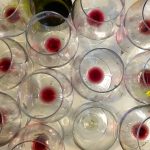What about Pieve de’ Pitti terroir?

Ok, this is a French word, but in the last 10 years, I didn’t find any better word to describe this, despite ‘Terroir’ is one of the most used and less understood wine words.
It’s the Climate
It’s the Soil
It’s the Terrain
But it’s also Microbes
And off course it’s also Man
and an unintellegible and indescribable mix of all of these.
This picture is the best Terroir advertising I found, travelling around the world. It was new Zealand
From a geological point of view, Pieve de’ Pitti is a perfect example of the variety of the Terre di Pisa area.
Many of the most representative geological formation of the Valdera area, exist here, from the Pliocene sands and clayey-sands, to the terraced floods to the blue clays.
Such a variety of textures, colour, chemical structures, permeability, density and fecondity.
Mix these elements on an hill that has steep slopes facing West, South-West and a gentle flat tabeland facing East.
Then add the sun, moving around, and the winds, that are blowing constantly from West, and hit the west side of the hill but spare the east one.
What a complexity, isn’t it?
Off course, we’ve planted a vineyard on any of the different soils. That’s why so many grape varieties. The one fits at best to the unique combination of all of the natural elements: soil, wind, sun, water.
a very technical soil description
The Lands of Pisa exhibit a variety of geological formations that were deposited in a chronostratigraphic interval of about 300 million years, from the Paleozoic (probably Carboniferous) to the Quaternary.
South of the Arno river, the Neogenic sediments of the neo-autochthonous complex outcrop extensively. These are marine and lacustrine sediments which were deposited during extensional episodes from the Upper Miocene to the Quaternary. The outcropping formations with the greatest fossil content are those of the Ponsano Sandstone (Lower Tortonian), of the Blue Clays, Calcarenite and Sands at Amphistegina and the Villamagna Formation (Pliocene) and of the Sands and Clays at Arctica, Sands of Nugula Vecchia and the Formation of Casa Poggio ai Lecci (Pleistocene). In these formations there are Bivalves, Gastropods, Brachiopods, Echinoids, Barnacles, Fishes, Reptiles and Mammals, both Marine and continental
For this reason, geologically, this plain is entirely made up of deposits of different environments: sea, lake, river, represented by clays, sands and gravels with deposits of peat and lignite, variously arranged in more or less thick discontinuous layers and lenses, all inclined from east to west. On the surface, the central part of the plain currently appears to be made up of river alluvials, while lake clays emerge in the peripheral parts.
Geology and geography have driven our choices in planting the vines, in order to intensify the influence of the natural elements in grapes ripening and taste.
Pieve de’ Pitti is a lucky place.
The sea is just closeby and the sea breezes blow constantly over the West and South-West-oriented vineyards.
The ocean was here in the past: soils are rich in shells and corals.
On the other side, facing East, the Sterza river flows now genlty but was large, impetuos and fertile in the past. Vineyards on the east side have been planted on a flat terracing, created by several overflowing, in centuries. Earth colours are bright, there. No shells but large wihite and rounded stones, makes our work more difficult but the ripening unique, reflecting the gentle sunlight all day long…
our soil, sun and winds maps







